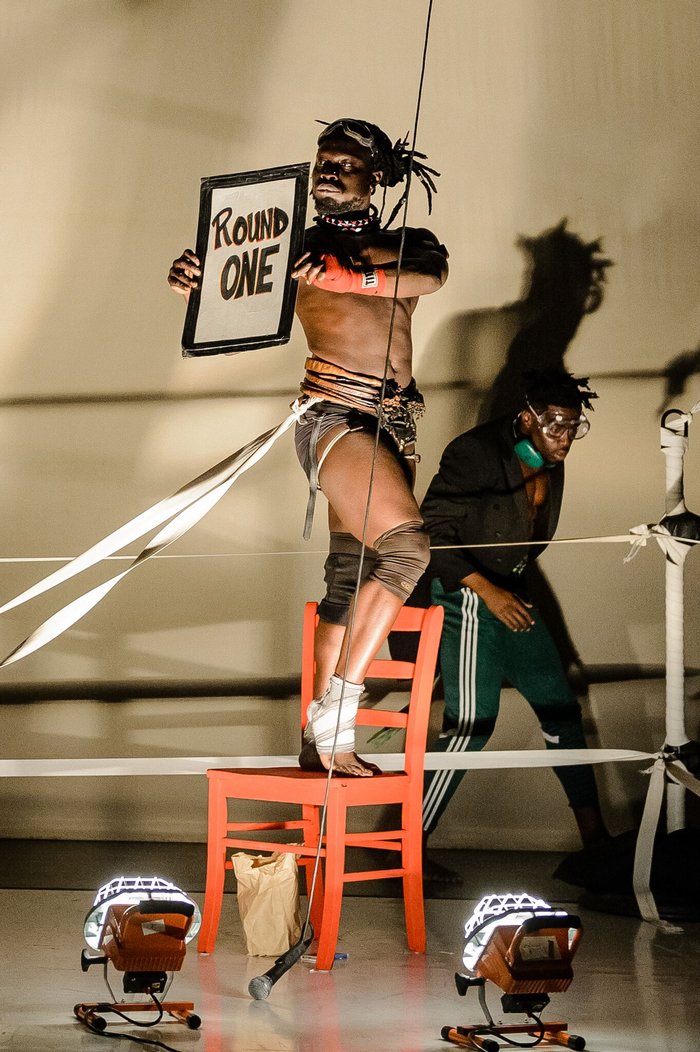Nora Chipaumire on decolonising herself
Interview: Esther Boldt
Interview: Esther Boldt
Esther Boldt: You are living in Brooklyn as well as in Zimbabwe. How do you experience these worlds?
Nora Chipaumire: I live in multiple times and multiple regions at the same time, being African, being Zimbabwean, and also working out of Brooklyn, New York. I am kind of circulating in different time signatures. When I am in Zimbabwe, I miss having the access and the speed of the digital world, that feeling of having everything at your fingertips. But there is also always this rich investment in time as a kind of physical material, whereas when I am in New York, there is abso lutely no time, it is like time is ether, it just vanishes. In Zimbabwe, you spend more time with people, people facetime and not the social media facetime. The pace and the speed of the digital world, it both has an efficacy and a kind of de-humanising feeling, so I feel grateful that I can be in two kinds of spaces at once. For me, it makes my work the kind of third space that it is.
EB: How often do you travel between New York and Zimbabwe?
NC: Well, as often as I can. My ideal equation would be half-and-half, but now it is like three months in Africa and the rest in the Western world, because of the economy of dance.
EB: Are you able to work in Zimbabwe?
NC: It is where I do my research and thinking, learning and re-learning. I am very much invested in understanding fuller, better, deeper the Shona-Person¹ that I am, the Shona-language which is my first tongue. I grew up under the Apartheid-System, and we were completely unable to reach into the fullness of our being as Shona-cultured-people. Now as an adult, I am interested in learning all those things that I wasn’t really taught. The main aim of the colonial project was to make everybody into a simpleton and a wage earner. For me now, it is really a pleasure to be in my own cultural spheres. That kind of work to me is real work, so yes, I work in Zimbabwe, very deeply and very profoundly, but it is work which is priceless. But nobody pays me to do it, so I have to find out how to survive when I am there, because, as everybody knows, Zimbabwe is bankrupt. To work there as a dance maker is really one of the most challenging things.
EB: You studied dance at different places, but you also hold a degree in law. What do law and dance have in common?
NC: Yes, my first focus was law in Zimbabwe, and what’s common as I have grown to understand is that my work is kind of litigious, it’s advocating. I think there is a great deal of things being on trial, being litigated and being at work…
EB: … or being processed…
NC: Or being processed. I guess that’s what the whole juridical system is about. This idea of justice, the law that most of the world practices, is highly influential. I am very much invested in that myself. And I think eventually that is what I carried from my understandings of law. I was a bad law student, although I liked the performative aspect of it. But I really believe in this question of justice and process, there is always a debate. It is never a one-sided kind of statement. There are numerous questions that are being proposed, and numerous answers proposed to it. I would say that is the relationship between my legal studies and my performative practice.
EB: In “portrait of myself as my father”, the negotiation starts with the title, because the word father is crossed out, so it is negated and present at the same time.
NC: Yes, of course! I think also in the legacy of Jean-Michel Basquiat², something is actually more present, when you do cross it out, and it leads you to more questions: Why is it crossed out? What is she trying to say? So already there is that negotiation.
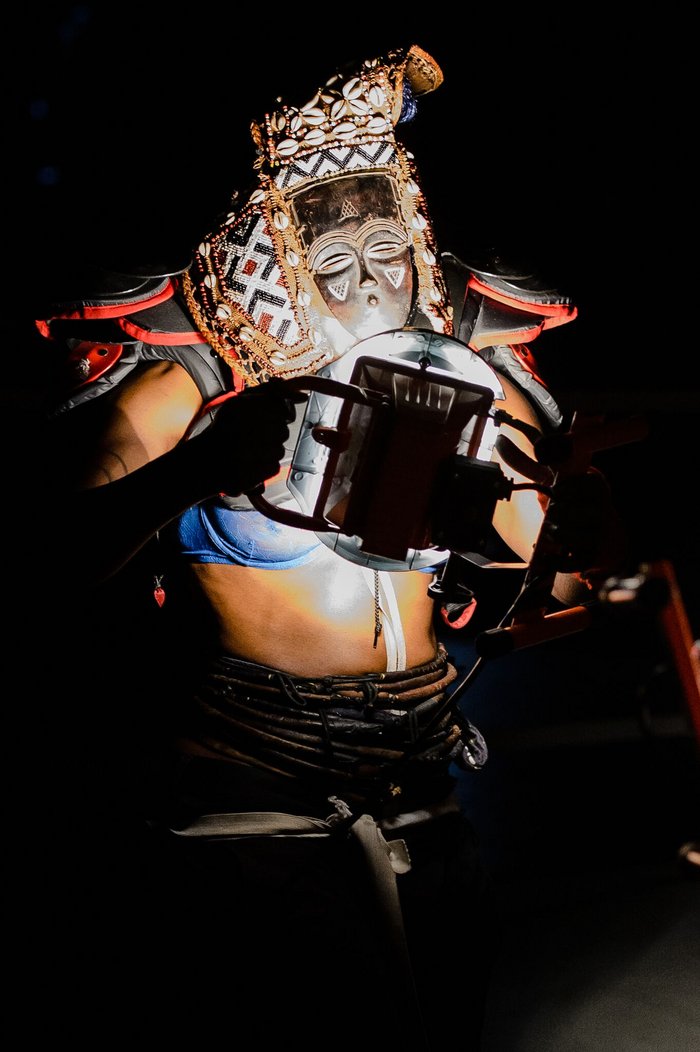
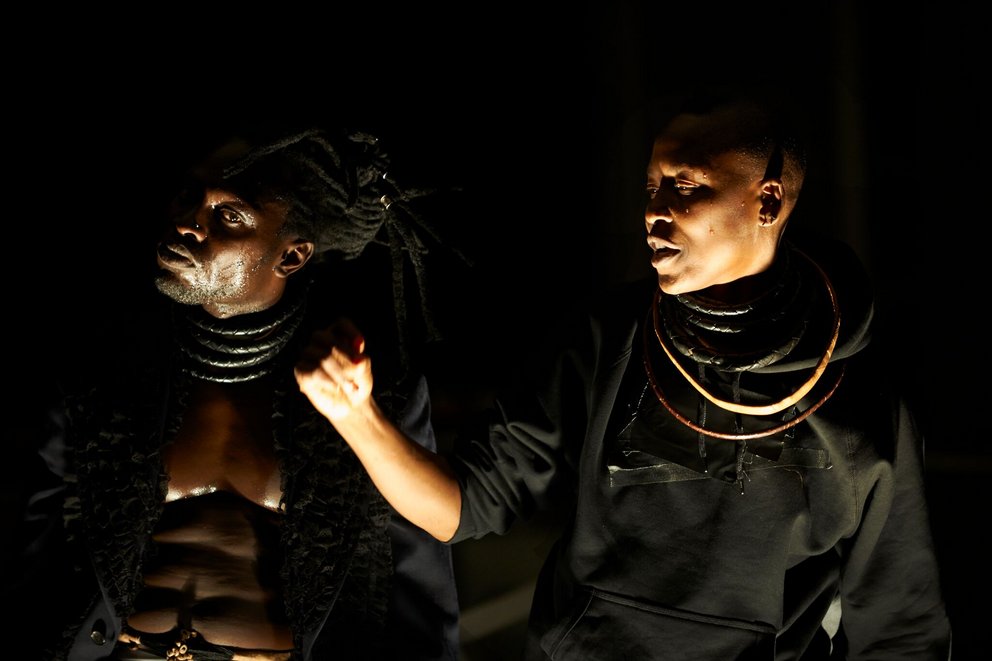
EB: So: Why is it crossed out?
NC: In part to make this very clear citation to Jean-Michel Basquiat, but also to really question this word ‘father’. My father was absent completely. But he was completely present in his non-presence, he was more real in my imagination because of his absence. And I wanted to query the whole idea and the history of fatherland and fathering, and I also wanted to put the men on trial. Men have put us in such a misery and such joys at the same time. Especially on the political platform, the creation of Africa comes out of this whole gathering in 1884, where guys just sat around and decided what part of Africa they were going to take.
EB: Are you talking about the Berlin Conference, where Africa was divided?
NC: Yes, the Berlin Conference, the scramble of Africa. My own father, Webster Barnabas Chipaumire, was completely a product of that conference. And if you think of it that way, as a historical problem, my father had very little tools to negotiate with the vastness of the colonial project. So never mind his absence from my personal life, he was actually absent from his own life.
EB: In your performance, there are being ten steps performed to become a Black African man. Is this a kind of anti-thesis?
NC: Yes, it’s completely an anti-thesis! Of course, there are no ten steps. But they were a wicked attempt not to just expose the problem, but to propose possible solutions.
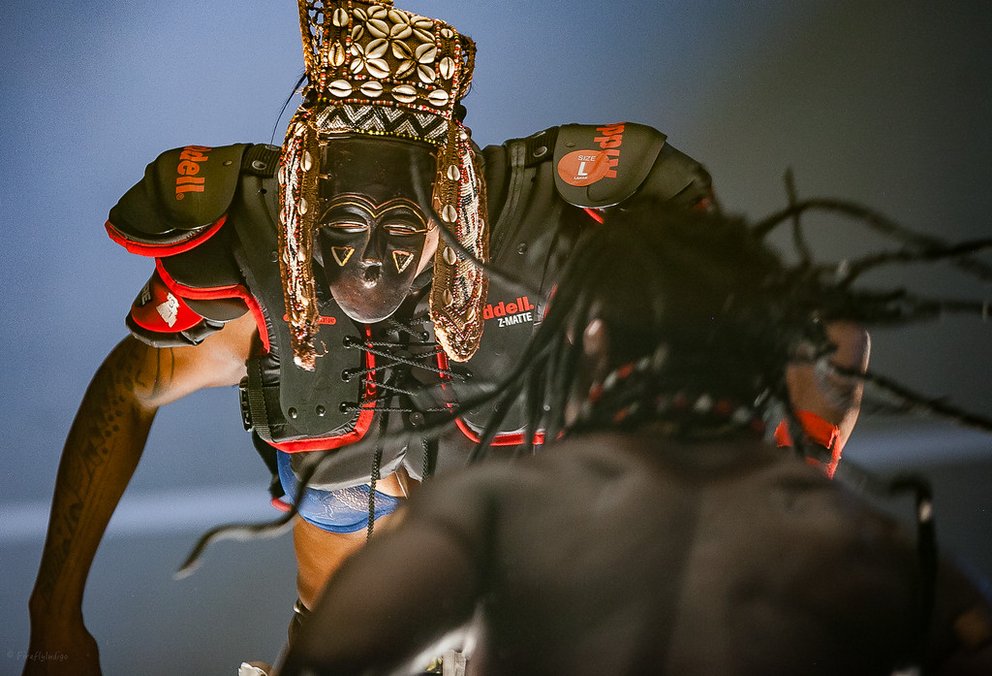
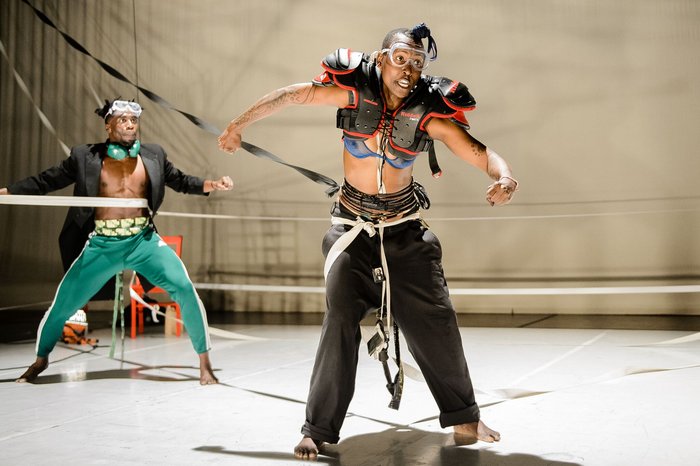
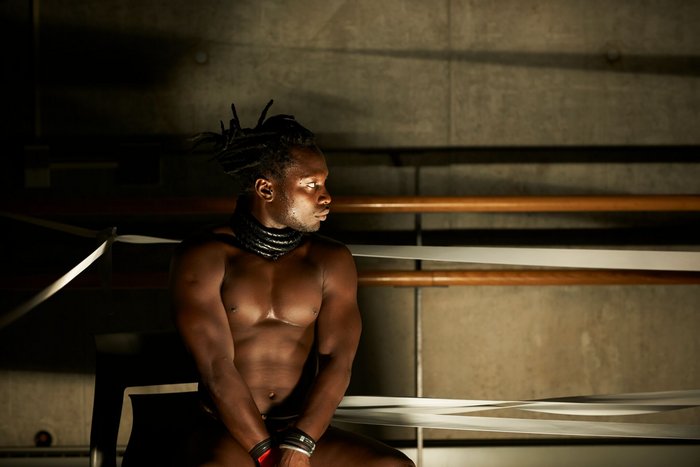
EB: Within these ten steps, you tie a very tight net between stereotypes and clichés, but you also quote role models or heroes like Nelson Mandela and Patrice Lumumba, so you entangle the utopian and the dystopian quite strongly. Is this an artistic strategy for you?
NC: Absolutely! For me it’s neither an utopia nor a complete dystopia. It’s in this third space I would like to propose as in the same way that perhaps Edouard Glissant³ was proposing Créolité⁴. But it is a sort of different type of space that Africa or a person like myself finds itself in. I don’t have European blood as such, but I have a pseudo-European education. My entire education was British. And all our exams were graded at Cambridge. Can you imagine? Here we are in Zimbabwe, writing Cambridge exams, reading about Keats and such and never about King Lobengula or the pre-colonial state Munhumutapa. In my project of decolonizing myself I feel that we are all caught in this web of utopia and dystopia.
EB: How do you decolonise yourself?
NC: Colonialism embedded itself very successfully in parts of our DNA. But that doesn’t mean that they aren’t parts that are pure and unpolluted with foreign ideas. There are places that are still untouched in my Shona-world. Reaching into that wormhole of Shona-ness, I am finding a pureness there. I feel that there is really a poverty of ideas in the Western world. If it is not attached to digital technology, there is not much happening really. For me, in many parts of Africa outside of the big cities, there is so much creativity, there is so much stuff happening, that doesn’t filter into these urban spaces. That’s what I am interested in really. And yet at the same time, I cannot un-politicize, I cannot remove myself from that which I know. I am already implicit and implicated in the British project.
EB: How does this pureness that you discover whisper into your work?
NC: I grew up around people who were embracing movement and the body. I wasn’t studying formal dance as such until I got into the West, and then I got involved in American modern dance and such. The purity that I am finding now is in terms of physical language, it is a way to use space, to use time, to use weight, all those aspects that make what we call dance: time, space and force. I’m really finding beautiful ways to think about it that are purely Shona. Even in the way my aesthetic has been developing away from the Western line, all of this has to do with this studying of myself.
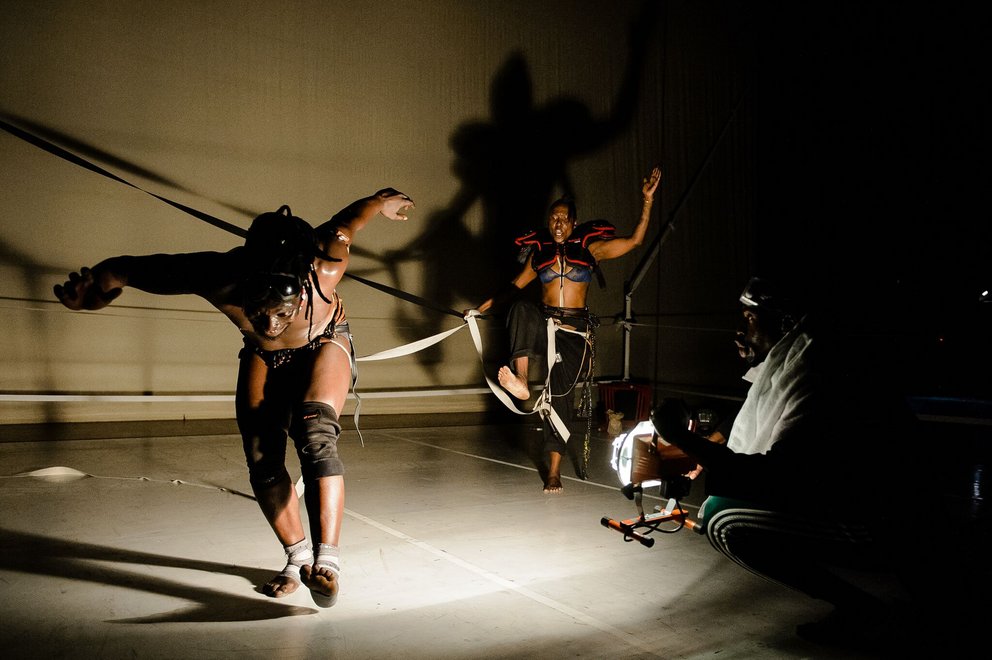
EB: Your aesthetic is quite unique, you are bringing together dance and theatre, postcolonial discourse, popular culture, club music and even acrobatics…
NC: It used to be: If you were a so-called ‘African artist’ and if you were not doing European aesthetic, so-called ‘white dance’, trying to look like you’ve understood the colonial project, you couldn’t go anywhere. Because if you used that canons that read as African, people said well, that that’s African dance, that’s not contemporary dance. But we don’t have to follow whatever Jérome Bel thinks is the right thing to do right now. In my culture, virtuosity and in fact philosophy is embodied in the body. With the works like “portrait of myself as my father” and “#punk 100%pop *n!gga”, which is what I am working on right now, I am trying to really imagine that everything was hunky-dory in Zimbabwe and the rest of Africa, and that the art economy there was fabulous and that you could tour marvelously into both urban stations and rural stations, and that all of the people where able to understand the work.
EB: So, you are trying to think of the Zimbabwean audience while creating the work?
NC: Absolutely. Always, because I am one, too. Of course, I am always the first audience for my work, but people like me are the intelligentsia. But I want to expand my audience, I want people who are not like me to understand the work. That means to really come up with an aesthetic that works, that is intelligent, so it’s neither about making work that is black or white, it is about making work that’s good.
EB: You toured a lot with “portrait of myself as my father,” you were in Senegal, in the US, in Europe. How is your experience with the different audiences? In Hannover, where I saw the piece, most of the elderly white men in the audience where quite provoked by it.
NC: Which I think is very successful, because that kind of generation knows exactly what is at stake in that work, and whether they are feeling European guilt, or white guilt, or male guilt or whatever, they get it. To me, their reaction is very much part of the discourse. Europe is so interesting with its African past, because the history of Europe is also the history of Africa. We are kind of tethered in this struggle, you and me. And certain generations will feel that tension greater than the younger generation, who only read about it, as it wasn’t part of their experience.
EB: In the piece, the music is quite present, loud, strong, sometimes even louder than the talk. How important is sound to you?
NC: Sound is super important. It is one of the materials that I really feel confident in dealing with. When I am home or anywhere on the continent, it is just like multiple sources of frequencies coming at you, and then you can either choose to sync with one, our you get utterly confused, or you’re just wheeling with the sheer volume and chaos of it all, in the urban areas particularly. I personally love the dissonance, I love the discord. The point is, there is a lot that we miss in that discord. I am interested in this space of black noise, not only John Cage was interested in noise, there has always been this production of noise, and I am really interested in claiming that space of black noise. We are great producers of this kind of noise. And I think in some ways too, it forces the public to really lean into the work, to listen more intensely. But at the same time, I am also testing the threshold. How far can you push the threshold of listening, or of focusing? How many languages can we throw into this melting pot? Swahili, Lingula, Shona, English, African French… the whole stew of what it could possibly be. What is the threshold really?
¹ Shona: a people of Zimbabwe and central Mozambique. The Shona include many subgroups, including the Karanga, Korekore, Manyika, Ndau, and Zezuru.
² Jean-Michel Basquiat (1960–1988) was an Afro-American artist. Today, he is recognised as one of the most significant painters of the 20th century.
³ Edouard Glissant (1928–2011) was a Martinican poet, novelist and theorist. He is especially known for his “Poetics of Relation”, an exploration of relational belonging as a decolonial poetic intervention.
⁴ Créolité: Créolité is a literary movement first developed in the 1980s by Martinican writers. Créolité, or “creoleness”, is a neologism which attempts to describe the cultural and linguistic heterogeneity of the Antilles and, more specifically, of the French Caribbean.
